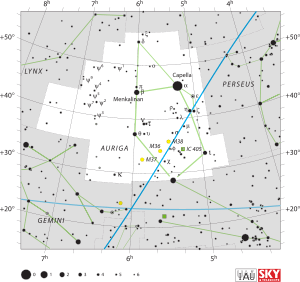Psi4 Aurigae
 | |
| Observation data Epoch J2000.0 Equinox J2000.0 (ICRS) | |
|---|---|
| Constellation | Auriga |
| Right ascension | 06h 43m 04.97107s[1] |
| Declination | +44° 31′ 28.0220″[1] |
| Apparent magnitude (V) | +5.02[2] |
| Characteristics | |
| Spectral type | K5 III[3] |
| U−B color index | +1.83[2] |
| B−V color index | +1.48[2] |
| Astrometry | |
| Radial velocity (Rv) | −77.35±0.23[4] km/s |
| Proper motion (μ) | RA: −45.43[1] mas/yr Dec.: −29.97[1] mas/yr |
| Parallax (π) | 10.08 ± 0.33[1] mas |
| Distance | 320 ± 10 ly (99 ± 3 pc) |
| Absolute magnitude (MV) | +0.06[5] |
| Details | |
| Radius | 33[4] R☉ |
| Luminosity | 245[4] L☉ |
| Surface gravity (log g) | 2.04±0.24[6] cgs |
| Temperature | 3,970±41[6] K |
| Metallicity [Fe/H] | 0.10±0.08[6] dex |
| Rotational velocity (v sin i) | 4.8[4] km/s |
| Other designations | |
| Database references | |
| SIMBAD | data |
Psi4 Aurigae, Latinized from ψ4 Aurigae, is the Bayer designation for a single,[8] orange-hued star in the northern constellation of Auriga. It is a faint star but visible to the naked eye with an apparent visual magnitude of +5.02.[2] With an annual parallax shift of 10.08 ± 0.33 mas,[1] it is approximately 324 light-years (99 parsecs) distant from Earth.
This is a K-type giant star with a stellar classification of K5 III.[3] It has expanded to 33[4] times the Sun's radius and is radiating 245[4] times the Sun's luminosity from its photosphere at an effective temperature of about 3,970 K.[6] The atmosphere displays a significant enhancement of silicon.[9]
References
- 1 2 3 4 5 6 van Leeuwen, F. (2007), "Validation of the new Hipparcos reduction", Astronomy and Astrophysics, 474 (2): 653–664, arXiv:0708.1752, Bibcode:2007A&A...474..653V, doi:10.1051/0004-6361:20078357.
- 1 2 3 4 Johnson, H. L.; et al. (1966), "UBVRIJKL photometry of the bright stars", Communications of the Lunar and Planetary Laboratory, 4 (99), Bibcode:1966CoLPL...4...99J.
- 1 2 Roman, Nancy G. (July 1952), "The Spectra of the Bright Stars of Types F5-K5", Astrophysical Journal, 116: 122, Bibcode:1952ApJ...116..122R, doi:10.1086/145598.
- 1 2 3 4 5 6 Massarotti, Alessandro; et al. (January 2008), "Rotational and Radial Velocities for a Sample of 761 HIPPARCOS Giants and the Role of Binarity", The Astronomical Journal, 135 (1): 209–231, Bibcode:2008AJ....135..209M, doi:10.1088/0004-6256/135/1/209.
- ↑ Anderson, E.; Francis, Ch. (2012), "XHIP: An extended hipparcos compilation", Astronomy Letters, 38 (5): 331, arXiv:1108.4971, Bibcode:2012AstL...38..331A, doi:10.1134/S1063773712050015.
- 1 2 3 4 Prugniel, Ph.; et al. (2011), "The atmospheric parameters and spectral interpolator for the MILES stars", Astronomy & Astrophysics, 531: 25, arXiv:1104.4952, Bibcode:2011A&A...531A.165P, doi:10.1051/0004-6361/201116769, A165.
- ↑ "psi04 Aur". SIMBAD. Centre de données astronomiques de Strasbourg. Retrieved 2017-09-28.
- ↑ Eggleton, P. P.; Tokovinin, A. A. (September 2008), "A catalogue of multiplicity among bright stellar systems", Monthly Notices of the Royal Astronomical Society, 389 (2): 869–879, arXiv:0806.2878, Bibcode:2008MNRAS.389..869E, doi:10.1111/j.1365-2966.2008.13596.x.
- ↑ Franchini, M.; et al. (January 2004), "Synthetic Lick Indices and Detection of α-Enhanced Stars", The Astrophysical Journal, 601 (1): 485–499, Bibcode:2004ApJ...601..485F, doi:10.1086/380443
External links
This article is issued from
Wikipedia.
The text is licensed under Creative Commons - Attribution - Sharealike.
Additional terms may apply for the media files.